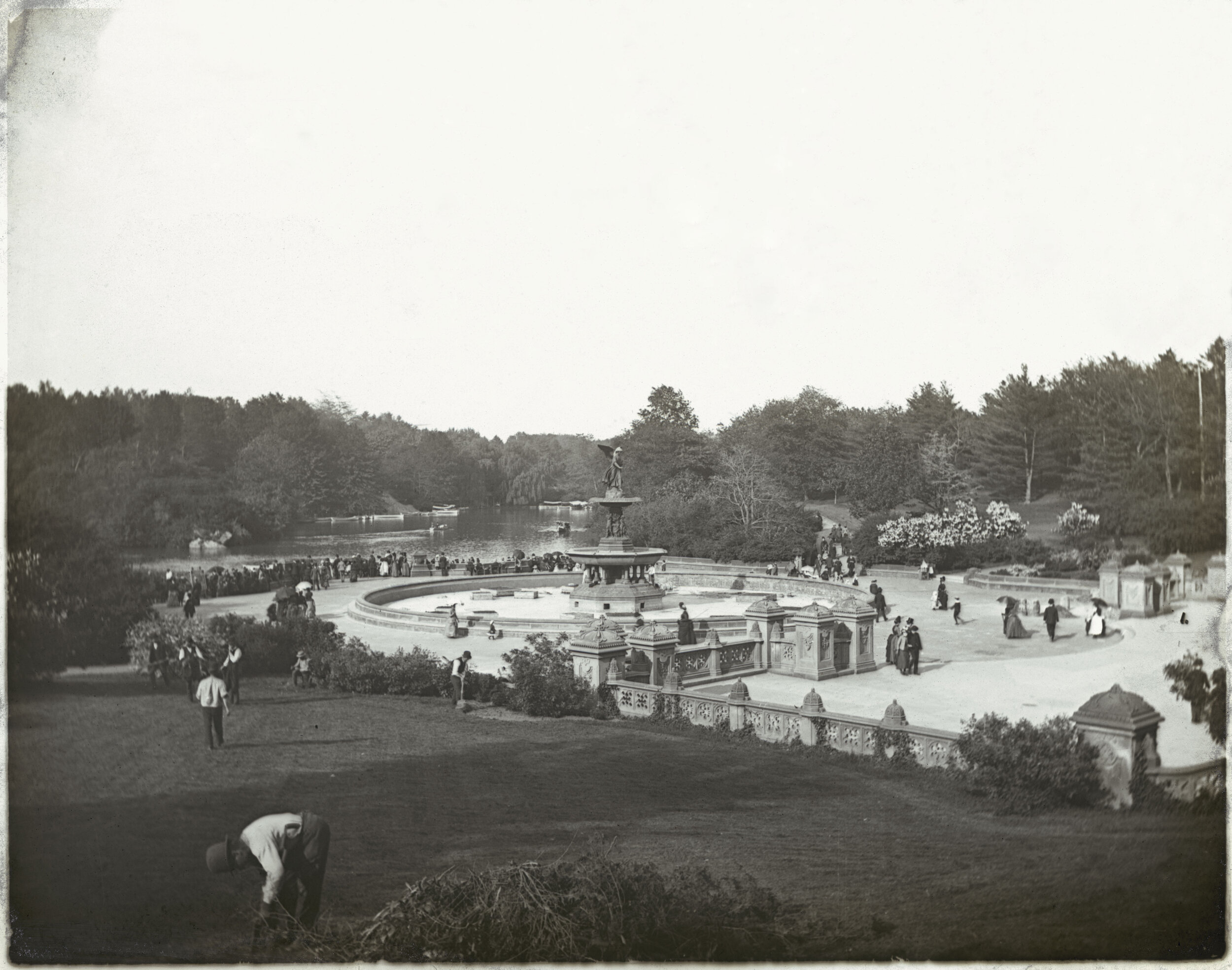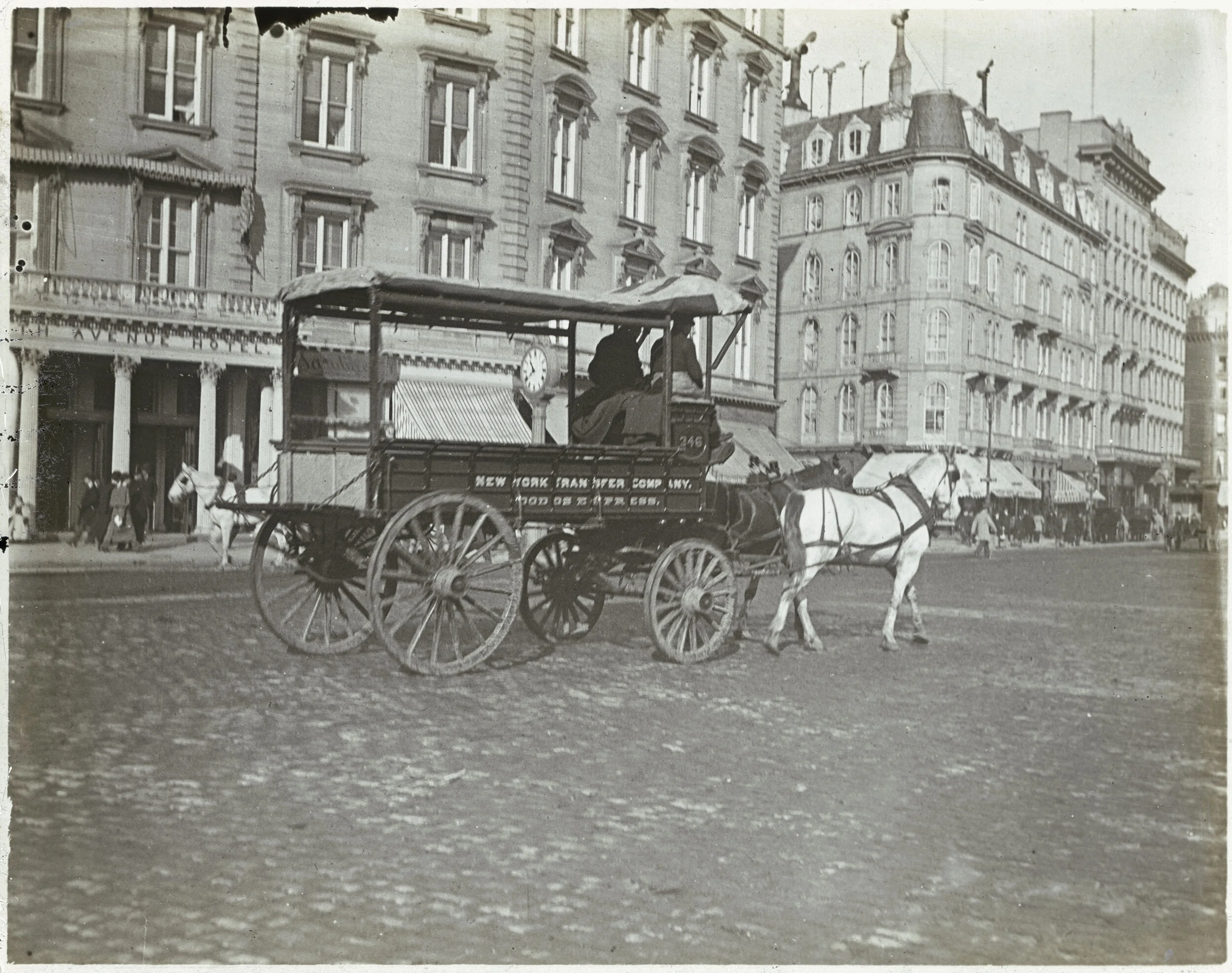Sometimes it is the exception to the rule that produces the most interesting result.
42nd Street, looking East to 6th Avenue, Manhattan, ca. 1890. De Gregario Lantern Slide Collection. NYC Municipal Archives.
On October 7, 1989, Leonora Gidlund, then head of collection processing, set up a table at the “Heritage Day” event sponsored by the Archivists Round Table of Metropolitan New York at the McBurney YMCA on West 23rd Street. Two visitors, Felice and Marion De Gregario noticed Ms. Gidlund’s display and asked if she would be interested in a donation to the Archives of four dozen 19th century lantern slides. The De Gregarios said they had found them in the basement of their home on West 13th Street in Manhattan. Ms. Gidlund explained that the Archives usually only took in records created by agencies, departments, or officials of NYC government, and not from private organizations or persons. But Ms. GIdlund was intrigued by the offer and asked for more information. And we are glad she did.
Bethesda Fountain and Terrace, Central Park, ca. 1890. De Gregario Lantern Slide Collection. NYC Municipal Archives.
The collection now known as the De Gregario Lantern Slides is fascinating and unique. Although only numbering 55 items, the slides provide rare views of iconic venues around the city—Central Park, the Brooklyn Bridge, Fifth Avenue, etc.—all dating from the last decades of the 19th century. Images from this time period are especially valuable as most City agencies did not adopt photography to document their work until after 1900.
Brooklyn Bridge from Coenties Slip, ca. 1890. De Gregario Lantern Slide Collection. NYC Municipal Archives.
On the appraisal report for the collection, Ms. Gidlund noted that the De Gregarios said their house had been owned by Robert Devlin some years before they bought it in 1967. They believed he may have been the source of the slides. Caption information on the slides attributed several to “Robert J. Devlin,” adding to the probable connection. Other captions listed “W. T. Colbron.” According to the “Guide to the Records of the New York Camera Club,” at the New York Public Library, Colbron was an amateur photographer who joined the newly-formed Camera Club in 1888. The Club had split from the Society of Amateur Photographers, founded in 1884.
Post Office, Broadway, near Vesey Street, ca. 1890. De Gregario Lantern Slide Collection. NYC Municipal Archives.
Perhaps further research in other Archives records would provide more information about Mr. Devlin and add to our knowledge of the collection’s origin.
The first stop in research involving a house or building is the property card collection. The cards provide basic information about every structure in the city—dimensions, classification, ownership, and assessed valuation—typically dating from the 1930s through the 1970s or 80s, depending on the Borough. They also include a photograph of the building taken circa 1940. (The original negatives of the prints have been maintained as a separate collection in the Archives. Recently digitized and available online, the “1940 Tax Photographs” are one of the Archives’ most well-known collections.)
153 West 13th Street, 1940 Tax Photograph Collection. NYC Municipal Archives.
After determining the block and lot number for 153 West 13th Street (Block 603, Lot 11), the card was quickly located. The conveyance section on the card listed an “S. Devlin” as owner of the building beginning in 1881. The 1881 date recorded on the card is very unusual; most property card conveyance information only dates back to the 1930s, when they were first created by the Department of Finance.
The next stop in the research quest was the 1890 “Police” census. It listed the inhabitants of 156 E. 13th Street as Samuel Devlin, age 55, Hannah Devlin, age 55, Robert Devlin, age 32, Samuel B. Devlin, age 23, and Mary Devlin, age 18. Although the 1890 census does not indicate relationships, it seems reasonable to assume that Robert, Samuel B. and Mary were the children of Samuel and Hannah Devlin, and that at some point Robert assumed ownership of the house.
Perhaps more details could be found to confirm that supposition. Luckily, for the purposes of this research, the De Gregario home was located in lower Manhattan which meant there might be a folder of applications in the Manhattan Department of Buildings collection. Indeed, there was. The earliest documents in the permit folder for Block 608, Lot 11 dated from a 1904 application to alter the building. In addition to information about the proposed alteration, the document indicated the name of the owner. And there he was: “Dr. Robert Devlin.” Devlin proposed to add a one-story extension to the back of the house to serve as an office. The alteration architect was Henry J. Hardenbergh, the architect of the Dakota apartment building on Central Park West, among other iconic structures.
Alteration Application 1392 of 1904 (detail). Department of Buildings Collection. NYC Municipal Archives.
The DOB folder contained other applications including one that listed the basement as being used for “photography,” although the time period of that function was not clear. Information listed on another application stated the building had been converted from a one-family to a two-family dwelling with a medical office in the basement, and funeral home on the first floor. That would seem an unfortunate juxtaposition – but perhaps these occupancies were not simultaneous.
Based on the knowledge that Robert Devlin was in New York City as early as 1890, and the pictures attributed to W. T. Colborn in the collection, it seems quite possible that Devlin was also a member of the Camera Club. Perhaps further research in the Club records at the New York Public Library would confirm Devlin’s association with the Club.
Hudson River Pier 42, Horatio and Jane Streets, ca. 1890. Photographer: Robert Devlin. De Gregario Lantern Slide Collection. NYC Municipal Archives.
This question may never be resolved, but it is obvious that these ‘amateurs’ were talented photographers. The pictures are well-composed and show that the photographer saw the value in documenting important places and events in the city’s history. And fortunately for historians today, lantern slides are a very stable medium. The emulsion layer is on glass and is protected by another layer of glass. Lantern slides are positive images and were intended to be projected for viewing, just like Kodachrome slides, or today’s Powerpoint presentations.
Here is a selection of more lantern slides from the De Gregario collection. And take a moment to look at the entire series in the gallery. You might agree that sometimes it is the exception to the rule that produces the most interesting result.
Crowds awaiting cornerstone laying ceremony for the General Grant National Monument, Riverside Drive and 120th Street, Manhattan, 1892. Photographer: W. T. Colbron. De Gregario Lantern Slide Collection. NYC Municipal Archives.
On board the S. S. Orinoco to Bermuda, ca. 1890. Photographer: W. T. Colbron. De Gregario Lantern Slide Collection. NYC Municipal Archives.
Boys roller-skating, Worth and Baxter Street, Manhattan, ca. 1890. De Gregario Lantern Slide Collection. NYC Municipal Archives.
Fifth Avenue and 23rd Street, Manhattan, horse-drawn wagon of N. Y. Transfer Company, ca. 1890. De Gregario Lantern Slide Collection. NYC Municipal Archives.










